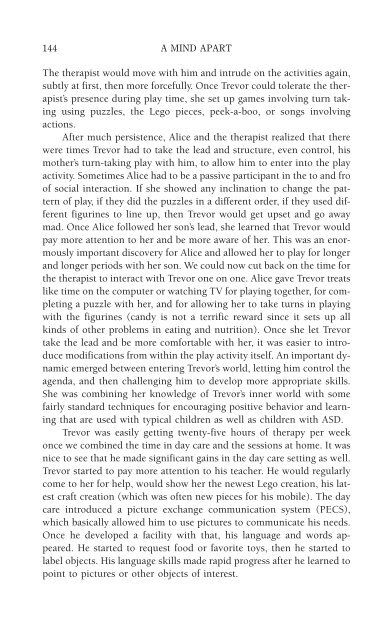978-1572305441
autism
autism
Create successful ePaper yourself
Turn your PDF publications into a flip-book with our unique Google optimized e-Paper software.
144 A MIND APART<br />
The therapist would move with him and intrude on the activities again,<br />
subtly at first, then more forcefully. Once Trevor could tolerate the therapist’s<br />
presence during play time, she set up games involving turn taking<br />
using puzzles, the Lego pieces, peek-a-boo, or songs involving<br />
actions.<br />
After much persistence, Alice and the therapist realized that there<br />
were times Trevor had to take the lead and structure, even control, his<br />
mother’s turn-taking play with him, to allow him to enter into the play<br />
activity. Sometimes Alice had to be a passive participant in the to and fro<br />
of social interaction. If she showed any inclination to change the pattern<br />
of play, if they did the puzzles in a different order, if they used different<br />
figurines to line up, then Trevor would get upset and go away<br />
mad. Once Alice followed her son’s lead, she learned that Trevor would<br />
pay more attention to her and be more aware of her. This was an enormously<br />
important discovery for Alice and allowed her to play for longer<br />
and longer periods with her son. We could now cut back on the time for<br />
the therapist to interact with Trevor one on one. Alice gave Trevor treats<br />
like time on the computer or watching TV for playing together, for completing<br />
a puzzle with her, and for allowing her to take turns in playing<br />
with the figurines (candy is not a terrific reward since it sets up all<br />
kinds of other problems in eating and nutrition). Once she let Trevor<br />
take the lead and be more comfortable with her, it was easier to introduce<br />
modifications from within the play activity itself. An important dynamic<br />
emerged between entering Trevor’s world, letting him control the<br />
agenda, and then challenging him to develop more appropriate skills.<br />
She was combining her knowledge of Trevor’s inner world with some<br />
fairly standard techniques for encouraging positive behavior and learning<br />
that are used with typical children as well as children with ASD.<br />
Trevor was easily getting twenty-five hours of therapy per week<br />
once we combined the time in day care and the sessions at home. It was<br />
nice to see that he made significant gains in the day care setting as well.<br />
Trevor started to pay more attention to his teacher. He would regularly<br />
come to her for help, would show her the newest Lego creation, his latest<br />
craft creation (which was often new pieces for his mobile). The day<br />
care introduced a picture exchange communication system (PECS),<br />
which basically allowed him to use pictures to communicate his needs.<br />
Once he developed a facility with that, his language and words appeared.<br />
He started to request food or favorite toys, then he started to<br />
label objects. His language skills made rapid progress after he learned to<br />
point to pictures or other objects of interest.



